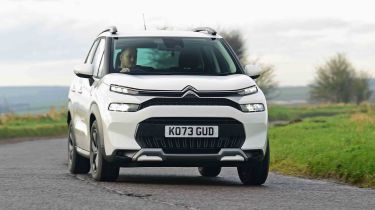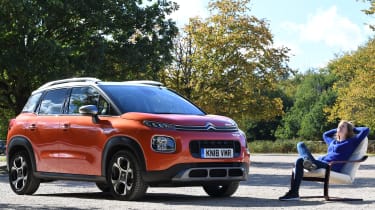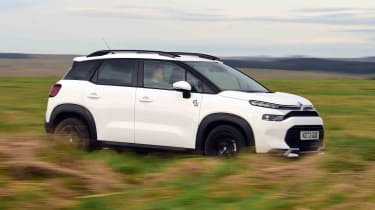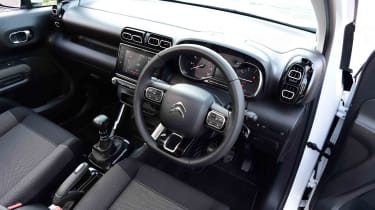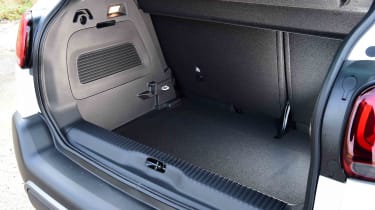Citroen C3 Aircross (2017-2024) review
The funky Citroen C3 Aircross is a practical take on the small crossover concept

Just so you know, this is an older review of the 2017-2024 C3 Aircross. If you are interested in information about the latest Citroen C3 Aircross, or news about the latest Citroen models, please follow the links provided.
The Citroen C3 Aircross offers relaxed cruising ability and promising fuel efficiency from a strong range of petrol and diesel engines. Ride comfort is decent, too, while the distinctive interior has lots of kit and useful family-friendly touches, made all the more practical following a mid-life refresh in 2021.
Despite the update, the C3 Aircross retains the funky looks we appreciated when it first arrived, while on-board tech upgrades have made the C3 Aircross a more convincing proposition to customers looking for a good family all-rounder.
About the Citroen C3 Aircross
If a category was made to promote the quirks of the latest Citroen range, it's the small crossover class. It first dipped its toe in the category with the now-discontinued C4 Cactus, and the Citroen C3 Aircross picks up the baton from that car, and continues to challenge more staid rivals in this competitive sector.
The C3 Aircross replaced the C3 Picasso small MPV in the range, but thanks to the C3 Aircross's dimensions, it has as much space inside as the old C3 Picasso.
Used - available now

2020 Citroen
C3 Aircross
25,475 milesManualPetrol1.2L
Cash £10,763
2020 Citroen
C3 Aircross
47,259 milesManualPetrol1.2L
Cash £8,587
2018 Citroen
C3 Aircross
49,274 milesAutomaticPetrol1.2L
Cash £10,387
2021 Citroen
C3 Aircross
47,509 milesAutomaticPetrol1.2L
Cash £12,397Under the skin, the C3 Aircross shares its platform and running gear with the Citroen C3 supermini. When the C3 Aircross was launched, it was available in a range of funky colours, and several personalisation options, but a facelift in 2021 has toned down the colour palette and options. You can still specify a black contrast roof, but the update focused on tweaking the exterior styling and altering the cabin with improved storage and a new infotainment set-up.
The C3 Aircross is available with a 1.2-litre three-cylinder PureTech petrol engine producing either 109bhp or 129bhp, and a 109bhp 1.5-litre BlueHDi diesel. The diesel and less potent petrol models both get a six-speed manual gearbox as standard, while the more powerful PureTech engine is paired with a six-speed automatic.
Despite its SUV-inspired looks, the C3 Aircross is front-wheel drive only, but Citroen does offer its Grip Control system that helps improve traction on sand, snow or rough terrain.
Equipment levels start with the entry-level You!, followed by mid-range Plus and top-of-the-range Max. The standard kit for You! includes 16-inch alloy wheels, cruise control, rear parking sensors, automatic air conditioning, and a seven-inch infotainment screen with Apple CarPlay and Android Auto.
Upgrading to the Plus trim adds a larger 9-inch touchscreen with Citroen’s Connect Nav infotainment system and a 3-year subscription to the brand’s Connected Navigation Pack services. The range-topping Max includes a top-down reversing camera, 17-inch alloys, and keyless entry and start.
The Citroen C3 Aircross goes toe-to-toe with several established rivals in the small SUV sector, including the Ford Puma, Nissan Juke, Toyota Yaris Cross, Dacia Duster and Renault Captur. There’s also competition from its Stellantis-owned sister firms, such as the Peugeot 2008 and Vauxhall Crossland.
Citroen C3 Aircross Flair long-term test
In 2018, our picture editor, Dawn Grant, ran a pre-facelift version, top-of-the-range Citroen C3 Aircross Flair for six months, clocking up nearly 5,000 miles. It was a bittersweet departure because Dawn likened it to getting rid of a favourite armchair, such were the comfort levels of this small SUV.
Some things did irk during that time, such as the fold-down armrests that got in the way when changing gear, while the numb steering and roly-poly handling meant Dawn and her husband often had to take things steady. However, the looks (and its vibrant orange paint – sadly no longer available) were a hit, plus the well-shaped and accommodating boot proved very handy, easily swallowing bulky suitcases over numerous airport runs.
Engines, performance and drive
On the move, the Citroen C3 Aircross feels pretty much like a slightly larger version of the C3 – and for the most part, that's no bad thing. The two cars share a lot of components because they're both based on the same PF1 platform.
This isn't the most sophisticated set of chassis parts on the market – indeed, it can be traced right back to the old Peugeot 206 – but a string of updates over the years has kept it respectable, and the C3 Aircross implementation is one of the best we've yet experienced.
It continues the PF1's well-known trait of allowing the occasional sharp road imperfection to jar through into the cabin, but the extra bit of travel afforded by the Aircross’s extra height does make it feel a bit more accomplished than the C3 supermini.
It hangs on surprisingly well with decent grip levels. The Aircross shows enough resistance to pronounced body roll, although it’s nowhere near as sharp as the Ford Puma on a twisty B road. And while the steering is far from communicative, it’s direct enough for you to learn to lean on it.
This is not the type of car that you'll get a great deal of enjoyment from driving at the limit – but should you carry a bit too much speed into a corner, it's worth knowing that the C3 Aircross will punish you not with any sideways drama but with predictable, consistent understeer.
We've tried examples on 16-inch and larger 17-inch wheels, and the larger tyres tend to scrub across the tarmac; the 16-inch wheels behave themselves, too, but there is a noticeable groan from the straining sidewalls.
The C3 Aircross isn't designed for serious off-roading, but Citroen does offer its Grip Control system as an option if you plan to get the wheels muddy from time to time. It's an advanced stability programme that helps to manage traction depending on the surface you're driving over – and it includes a hill descent setting that will take the car down steeper slopes at a gentle, easily controlled speed
0-62mph acceleration and top speed
The 1.2-litre PureTech petrol engine is available in two power outputs – 109bhp and 205Nm or 129bhp and 230Nm. The former allows the small French SUV to go from 0-62mph in 10.1 seconds, while the more powerful unit cuts that time down to 9.2 seconds. The 1.5-litre BlueHDi 110 diesel unit produces 109bhp and 250Nm; enough for a 0-62mph time of 10.8 seconds.
The top speed for the 109bhp petrol and diesel models is 114mph, while the 129bhp petrol version will hit 121mph.
We're very familiar with the 1.2-litre turbo petrol engine in the C3 Aircross – it's used in various Peugeot and Citroen models. It's a refined enough engine, only feeling slightly strained when you get above 4,000rpm, but possessing enough torque to ensure you don't have to do that very often. The 109bhp PureTech 110 offers the strongest mix of performance, economy and price.
The auto box, meanwhile, is generally smart enough to provide swift, smooth gearchanges in regular driving. However, when tackling a twisty country road, it isn’t as responsive as the equivalent dual-clutch gearbox used in rivals like the SEAT Arona, Skoda Kamiq, and Volkswagen T-Cross.
MPG, CO2 and Running Costs
Citroen is pitching the C3 Aircross as a larger, more upmarket vehicle than the C3 supermini. As such, list prices are higher than the regular C3, although the starting figure for the C3 Aircross is still low compared with many of its rivals.
The most frugal C3 Aircross is the BlueHDi 110 diesel, which has a six-speed gearbox and returns up to 67.2 mpg on the WLTP combined cycle. CO2 emissions also start from just 128g/km.
The petrols can't match the diesels' official figures, of course, but the PureTech three-cylinder engine is one of the more efficient offerings in this area of the market, and its numbers are no disgrace in a car of this size. The 109bhp petrol manages an official combined economy figure of 54.4mpg with CO2 emissions from 134g/km.
The more powerful 129bhp petrol uses a six-speed auto transmission and returns a healthy 47.3mpg, although emissions are a little high, ranging from 140-151g/km depending on your chosen spec. On the whole, though, the C3 Aircross is one of the more efficient offerings in the class, but there are more economical hybrid rivals, such as the Toyota Yaris Cross, that can get 60mpg or more in regular driving.
Insurance groups
Premiums for the C3 Aircross shouldn't be too expensive – diesel models sit in insurance group 15, while petrol-powered versions land in group 18 for the 109bhp version, and 21 for the 128bhp model.
The Renault Captur should be more affordable to insure because it has a less powerful model with lower insurance rates, starting at group 8 for an entry-level 99bhp version.
Depreciation
According to our expert information, after three years or 36,000 miles, the C3 Aircross range should hold on to between 45 and 55 per cent of its value, with the worst performing model being the 1.5 BlueHDI Max model, and the best being the 1.2 PureTech You! trim level.
That is on par with rivals like the Ford Puma and Volkswagen T-Cross, both of which are more expensive to buy in the first place.
To get an accurate valuation on a specific model check out our free car valuation tool...
Interior, design and technology
The Aircross certainly looks the part, with a beefy evolution of the C3 supermini's looks. A mid-life facelift in 2021 saw exterior changes, including slimmer headlights, a wider grille, and revised running lights. The interior also saw a spruce up, with a redesigned centre console, and an increased number of storage cubbies to improve the car's everyday practicality.
The side profile is dominated by the 'floating' roof, which can be enhanced further through the choice of a black contrast colour and, as part of a colour 'pack', a different shade of exterior parts, including the roof bars and door mirrors. This pack also brings graphics for the C-pillar, which is blacked out otherwise.
There’s a choice of six exterior colours, of which Polar white is the only free colour, while the other five can be specified for a little under £600. The contrast rood is standard on the top-of-the-range Max trim level, or costs £300 on every other model.
The interior is about par for the course in the class, though, with hard, scratchy plastics never too far away from your touch. At least the front seats offer something different; they're part of Citroen's 'Advanced Comfort' approach, so they're wider and a bit more cushioned than you'll normally find. They remain surprisingly supportive on twistier roads, too.
Up front is pretty standard fare, with analogue instrument dials – although a head-up display is available as an option.
Sat-nav, stereo and infotainment
Citroen infotainment systems are generally frustrating, and this applies to the C3 Aircross. It’s attractive to look at, but proves to be irritating to use – especially on the move.
The entry-level You! comes with a small seven-inch screen, while mid-range Plus and above come with a larger nine-inch display. There’s not much difference between the two in terms of useability because the menu layouts on either screen are awkward to use, have long loading times, and aren’t particularly responsive to your inputs. Worse still, window heating aside (that still uses a physical button), most of the climate functions are only accessible through the screen.
Mid-range Plus trim and above have a built-in navigation system that boasts Real-time traffic, a three-year subscription to live traffic, weather, and fuel price data. It’s nice to have, but still isn’t the easiest to program, so you’re better off utilising an app from your smartphone through the standard-fit Apple CarPlay and Android Auto phone connectivity.
Practicality, comfort and boot space
Small SUVs generally have a whiff of 'emperor's new clothes' about them, because they're usually more expensive than their supermini relatives without offering more space.
The C3 Aircross manages to buck this trend. Its wheelbase is longer than a regular C3's by around 60mm, translating into a rear cabin that can cope with a couple of adults for a reasonably long journey. They're unlikely to complain much even if their knees graze the front seat backs, because the seats are so soft and squishy.
A mild redesign of the centre console and other cubbies formed part of the facelift in 2021, and the interior now includes a useful lidded storage bin, which can be used by both front and rear occupants to hide away small items from view.
Headroom could be more of an issue, especially if the C3 Aircross has the panoramic sunroof fitted. There's no denying its appeal because it bathes the cabin in light and prevents it from becoming gloomy, but it makes head room more of an issue for rear passengers over six feet tall.
Up front, there are wider, softer seats than you'd commonly find in the class, and they're supportive enough not to give you backache on a long journey. Headroom is less of an issue for the front occupants, even with that sunroof.
The boot is a useful 410 litres with the rear seats pushed back, and you can slide them individually to increase this capacity to up to 520 litres, or fold them down completely to open it up to 1,289 litres. Mid-range Plus trim comes with an adjustable height boot floor, allowing you to prioritise either a flat load bay with no awkward step when the rear seats are folded, or drop the floor to its lowest setting to increase overall capacity. There’s also a neat vertical slot at the foremost edge of the boot, for you to tuck the parcel shelf away and accommodate taller loads.
Size
The C3 Aircross is 4,155mm long, 1,765mm wide and 1,637mm tall. That makes it around 16cm longer than the C3, and taller by a similar amount. It’s also a little longer and taller than a Renault Captur, and the SEAT Arona – although the Spanish offering is a few millimetres wider.
Leg room, head room & passenger space
Think of the C3 Aircross as a halfway house between a supermini cabin and a family hatchback. There’s plenty of room for two adults up front, and two fully grown adults should be able to sit behind them in relative comfort (soft, squidgy front seat backs help with this, by allowing rear-seat occupants to press their knees forwards).
Headroom is a little more of an issue – especially if you choose the panoramic sunroof. It does make the cabin much brighter and more airy, but it cuts away a few centimetres of headroom; this is especially true in the rear cabin, where six-footers will feel the top of their heads rubbing on the lining.
Can the C3 Aircross operate as a five-seater? The answer is yes, but despite the lack of a big transmission tunnel in the middle of the floor, it’s probably best if the thinnest of the group sits in the centre rear seat. And three adults are likely to find their shoulder space a bit restricted, especially during a longer journey. In this respect, at least, the Aircross can’t quite shake off its supermini origins.
Those with small children will be pleased to know that two ISOFIX child seat anchor points are provided on the rear bench's outer positions.
Boot
Small SUVs don’t have a great reputation for delivering any more practicality than their supermini cousins, but the C3 Aircross bucks the trend by offering a genuinely useful boot. Its capacity is 410 litres with the rear seats in place, and you can slide them forwards (either as one, or using the 60:40 split) if you want to increase this to 520 litres.
With the seats folded, there are 1,289 litres of space on offer – not exactly a rival for an estate car, but usefully capacious. You can also move the boot floor to prioritise either capacity or a flat load area with minimal lip.
Reliability and safety
Based on the results of our 2023 Driver Power owner satisfaction survey, the C3 Aircross finished 74th on our list of 75 of the best cars to own. That’s a shame considering the larger Citroen C4/e-C4 was named the best car to own, and Citroen as a brand came 11th (out of 32) in the best car manufacturer rankings.
Safety experts Euro NCAP awarded the C3 Aircross a five-star rating back in 2017. Unfortunately, the test has become progressively tougher since then, so this rating has expired. That’s a bit of a shame because the SEAT Arona was also tested in 2017, but has since been re-tested in 2022, and with a few subtle updates, it still has a five-star rating.
Even if the C3 Aircross is retested, it most likely wouldn’t get a very high score because autonomous emergency braking (AEB) is only fitted to high-spec Max cars, rather than to the whole range, as in the case of the Arona. All C3 Aircross models get electronic stability control, lane departure warning, traffic sign recognition and tyre pressure monitors, though.
Warranty
The C3 Aircross comes with a pretty standard warranty – two years of unlimited-mileage manufacturer warranty cover, and a third-year with a limit of 60,000 miles. This level of protection is just about par for the course across the industry, but some of the C3 Aircross’s rivals do offer more – notably the likes of the Hyundai Kona and the Kia Stonic, which come with warranties lasting five and seven years, respectively.
Servicing
Citroen offers fixed-price service plans for the C3 Aircross, covering you for between one year or 10,000 miles, to four years and 150,000 miles (whichever comes first).

